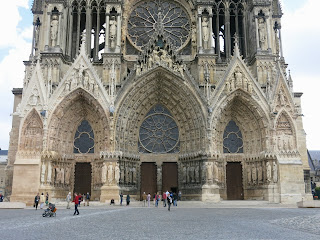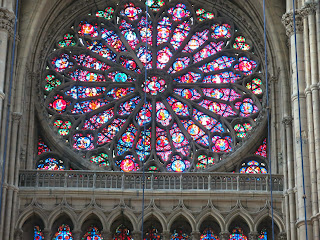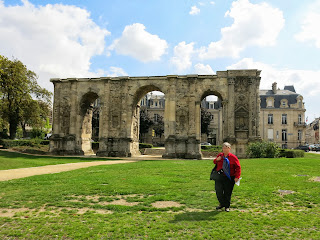We took the highspeed train to Reims. Our top speed was 316
k/hour or196 miles/hour. The country
between Paris and Reims reminded me a lot of southeastern Minnesota- farms,
rolling hills, lots of trees. Train was travelling too fast for me to take
pictures.
Reims seemed very quiet after Paris. We later discovered that we were a couple of
blocks away from the main business streets. Reims has a trolley system, but we
found it quite walkable.
Since 496, it has served as the place for coronation of 26
kings, with France’s last king crowned there in 1825. Joan of Arc travelled
across the same area as our train travelled to lead Charles VII to be crowned
there. The French rallied around him to push the English out of France and
finally end the Hundred Years War. Hooray for Joan.
The current cathedral was started in 1211, severely damaged
in WW I, and then completely re-built by John D. Rockefeller.
Unlike Chartes and St. Dennis (and perhaps some others I have not seen), the West Portal (entrance) does not depict Judgment Day.
A pretty altar.
A favorite statue is the smiling Angel. I read that Reims is the only place with
angels whose wings are spread.
Unlike Chartes and St. Dennis (and perhaps some others I have not seen), the West Portal (entrance) does not depict Judgment Day.
A pretty altar.
Joan of Arc has a chapel, and a lovely statue. I lit a candle in her honor.
My candle is the red one.
My candle is the red one.
A chapel to Mary.
Like the other Gothic churches, there are rose windows, flying buttresses, and
pointed arches.
Also, lots of gargoyles, which were much more prominent that some of the others I have seen.
Also, lots of gargoyles, which were much more prominent that some of the others I have seen.
A walk past Ponts de Mars. An entry gate to the town from second century
A.D. which was one of 4 entrances into the town. It is the only one left.
On to the Museum of the Surrender, which is located at the
end of a high school (fortunately, the museum and school have separate entrances). The
entire building was Eisenhower’s headquarters at the end of WW II.
A large room on the 2nd floor has
the original war maps are on the walls.
The treaty ending WW II was signed in the room. Since my dad was in WW II, this was a must
see for me. The treaty was signed in early morning of May 7, but not announced
until May 8, Victory in Europe Day.
I remember my dad telling me of marching through France at that time, and the French
saying”merci, merci.” He thought they
were asking for mercy.
Table where the treat was signed.
Germans who signed the treaty. Hitler had committed suicide a week earlier.
Eisenhower's letter stating the treaty has been signed.
Detroit newspaper announcing the surrender.
Some time before our train returned to Paris. So
what does a person in France when this happens?
Sit with a cup of coffee, or glass of wine and watch the world go by.Table where the treat was signed.
Germans who signed the treaty. Hitler had committed suicide a week earlier.
Eisenhower's letter stating the treaty has been signed.
Detroit newspaper announcing the surrender.



































































No comments:
Post a Comment